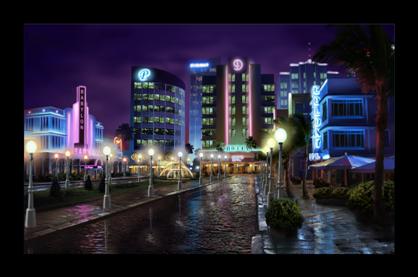|

This unit of study centers on Computer Game World Creation Theory. You will gain knowledge of the different types of
worlds, and the attributes that you should develop in order to create memorable game world. For this unit, you will work individually
to develop the world environment for the computer game you are proposing to write.
Last Week We learned what characteristics and qualities make good characters for your video games. We
will expand on the ideas of theme, genre, and environment by looking at different character archetypes for use in your game.
This Week We will be looking at what characteristics
and qualities make good worlds for your video games. We will expand on the ideas of game structure goals, flow, duration,
availability, relationships and progression. We will explore the different types of world time: authentic, limited,
variable, player-adjusted, and altered. We will complete our unit with a discussion of game level space as it relates to perspective
and camares, terrain and materials, radiosity and effects, scale, boundaries, reality and style.
In this unit we will take a physics or "space-time" approach to level design-- focusing on how designers
construct the architecture and visuals of the physical game environment, and how they divide up the basic structure of the
world into different sections (levels).
Questions we will answer this week:
1. What is game design and how is it realted
to gameplay?
2. What is the importance of the structural features of
game worlds -- such as duration, availability, relationship, and progression?
3. What is the importance of the temporal features of
game worlds -- such as authentic, variable, player-adjusted, and altered?
4. What is the importance of the spatial features of
game worlds -- such as perspective, scale, and boundaries?
5. How are reality and style achieved in a game environment?
Assignment Due Next Week:
Play a game
and analyze how the game handles structure. Is the game split up into levels? Does each subsequent level increase in difficulty?
That type of progression is demonstrated in the game?
The 3D game
development tradition has been criticized for being too imitative -- creating worlds that aren't distinct enough from one
another. If you were to develop a 3D game, how would you ensure that the game reflected your unique style?
Design a game
environment for your original game idea. What materials will you use? What sort of objects of structures will you add to the
environment?
Click
on the following link, and complete the attached WebQuest:
Game World Creation WebQuest
Helpful
Resource Links
http://www.magnifiers.org/ - This website offers resources for screen enlargement and speech technologies. These Magnifiers
are free and easily downloaded. They have proven to be quite effective for enlarging the game screens without distorting the
graphics capabilities.
http://www.twitter.co.uk/ - This is a link to a talking typing tutor for beginners. In addition to word processing
with a spell checker, talking dictionary and thesaurus, e-mail, text-only Web browsing, and facilitates student improvement
of keyboard skills with the use of a talking typing tutor.
Helpful Game Download Links
All of the following links offer free downloads or free demonstration periods for their games.
The http://www.bavisoft.com/ - offers audio gaming. Bravisoft.com have introduced audio games powered purely with cd-quality
sound imagery, Bavisoft provides game players with unparalleled music and sound quality. Their flagship title, Grizzly Gulch
Western Extravaganza is a mix of an action and adventure game.
The V.I. Guide has an extensive set of links to text-based and speech-friendly computer games.
"ESP Softworks is in the development stage of producing several games and entertainment software titles.
Games for the Blind sells games "designed and written specifically for blind gamers. They offer about ten different
games.
GMA Games designs sophisticated Windows-based games that are fully accessible. The first offerings include
"Lone Wolf," "Trek 2000" and "Shades of Doom."
"Zform is a new software entertainment company focused on creating games. Using parallel audio/video interfaces and Internet play,
Zform plans to conquer the "graphical divide" between gamers."
Copyright 2005,
Leslie Spivey. All Rights Reserved. Last revised December 8, 2006.
|
